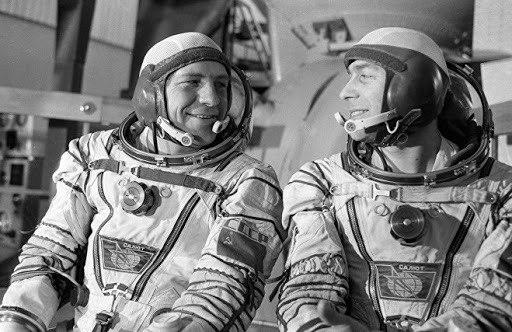
History 14/03/20 Why Soviet astronauts saw the stars in space, and the us – no
Yuri Gagarin in the official records of his spaceflight, described his observations:
“the Earth from this height – 175-327 miles – very well seen… the Sky is absolutely black. The stars in this sky look a little brighter and more clearly visible in the background of this black sky”.
In this case Gagarin talking about his observations in the light of the Sun, as it describes what can be seen in this light on the surface of the Earth.
the Starry blindness American astronauts
When the American astronauts brought back the first photographs from the moon’s surface, many would ask why they can not see the stars in a totally black sky. In answering these questions, Neil Armstrong once said, “If you look at the black sky, you can imagine that you are on is strewn with sand Playground at night, under the dazzling floodlights. No stars, no planets, except Earth, not to be seen.”
Armstrong could say that it is one thing – the camera lens is set to a certain light exposure, and the other eye. Probably, if to do with the surface of the moon pictures of the sky, which would have been visible stars, no details will not be visible on the surface – it will be flooded with an even bright light. But the eye is able to quickly adapt to objects of different brightness levels. Especially when viewed from the shadows. The shadows have American astronauts on the moon, in theory, should be enough and at least the shadow of the landing module “Apollo.”
But Armstrong reiterated the fact that before him others have said, the Americans flew, according to the assertions of NASA, into orbit and to the moon – in space the stars are not visible, their light completely hammered by the Sun.
the American writer Ralph Rene, author of sensational books about the Apollo program “NASA has shown amertancom the moon”, collected the statements of the astronauts that they saw in orbit, starting with the first of them, made a suborbital flight of Alan Shepard.
“Shepard reported that the stars are not seen… Virgil Grissom repeated the 15-minute ballistic flight. And it turned out that he did not see the stars… John Glenn achieved orbit, its flight lasted almost 5 hours. After it was picked up in the cold waters of the Atlantic, he said that he saw a few stars and even a few of the constellations… In the next phase, NASA has fitted out several expeditions for a longer time. But the improvement in the incidence of the starry blindness was not… If the Russians, who did not suffer this disease, know that the cream of American pilots – the star-blind, the theory of Domino, we will be crushed boiled the heel of the Shoe, which Soviet General Secretary Nikita Khrushchev beat the podium of the UN.”
the Irony of Ralph Rene all the more pertinent that Soviet cosmonaut after Gagarin, talked about what’s good seen stars with an orbital day, when the top shone dazzling in the vacuum of space, the Sun, and the bottom added light bright blue Earth.
Stellar impressions of Soviet cosmonauts
“And now I’m on the belt sticking out of our space “the passage,” – said Alexey Leonov on the first ever spacewalk. – First impression? Sun. Disk smooth, without halo and rays, but can not be blind. And the sky is very black and starry. Stars and the bottom and top. Sun night! Or the day star? Breath away”.
Later in his book, “the Color palette of the space,” Leonov said the conditions of observation of the stars from orbit: “Stars in space can be observed not only at night but also at daytime sky. However, at a sufficient distance from the Sun. But on the opposite, shady side of the ship of stars visible is almost the same as night.”
This impression was confirmed by other Soviet cosmonauts. Here the words of Alexander Serebrova, ten times coming out into the open space: “I’m from thel and stars, and Land in the blue aura of atmosphere.”
Compare with this the statement of the partner of Armstrong, Edwin Aldrin, made years after the flight to the moon in his book: “In the early flights of the NASA scientists suggested that astronauts could see stars during the day. But the astronauts soon realized that they had seen stars in orbit only when they were in earth’s shadow, it is night.”
For observations of the moon, the appropriate comparison with observations in orbit that’s when the spacewalk. There is a vacuum there and there is an open space where nothing interferes with the light sources. And the sight of the ship the most powerful sources of light can be obscured. And to see the stars from a ship should be much easier.
Therefore, many were surprised that the astronauts “Apollo” was seeing stars, even from the portholes of the ship. The crews for the first lunar expeditions (“A-8, -10 and -11”) was completely “star-blind”. Alan Bean on “A-12” it was said, however, that saw stars from the top hatch of the ship. And Eugene Cernan in the “A-17” said that when you look from the shadows on the moon in the sky see individual bright stars. This fun evolution of the observations of Ralph Rene ironically called “star blindness correction in the further course of NASA”.
it Seems to be the sun shines the same for Russian, American space travelers, and the Earth beneath their feet is the same, and the stars in the sky are the same. But only by comparing their descriptions, you would think that they and others flew from different planets and even different universes.
the Americans were Flying into space in the 1960-ies
Attempts to explain the differences in observations of Soviet and American space explorers the fact that Americans interfered with the bright surface of the moon, calculated on the ignorance and slowness. The moon reflects only 7% of the incident light. The Surface Of The Earth Is 30%. In orbit the near-earth space ships Land covers almost half of the visible space – almost like the Moon, we have to stand on the surface of the latter.
Therefore, the lighted day, the Earth must stop to see the stars from orbit even more than the illuminated surface of the moon as seen from the moon. However, we have seen in space the stars by day, Americans are not. And not only from the moon but from earth orbit.
To explain the difference in the readings there is only one explanation that most historians of Astronautics, and other high-status experts, journalists, politicians, etc., is considered eccentric and marginal. It consists in the fact that Americans don’t actually fly to the moon (Ralph Rene, Yuri Mukhin, Alexander Popov). Given the lack of stellar experience with the astronauts in earth orbit, authors such as Sergey Eremenko, argue even that the end of the 1960s, the Americans did, in fact, only suborbital flights.
a Coherent alternative point of view explaining the observed paradox in the framework of the official version of NASA about what really happened the flights to the moon, not formulated.
Yaroslav Butakov
Source:
© Russian Seven
Featured articles Share: Comments Comments on the article “Why the Soviet astronauts saw the stars in space, and the us – no” Please log in to leave a comment! br>
Share on Tumblr
















